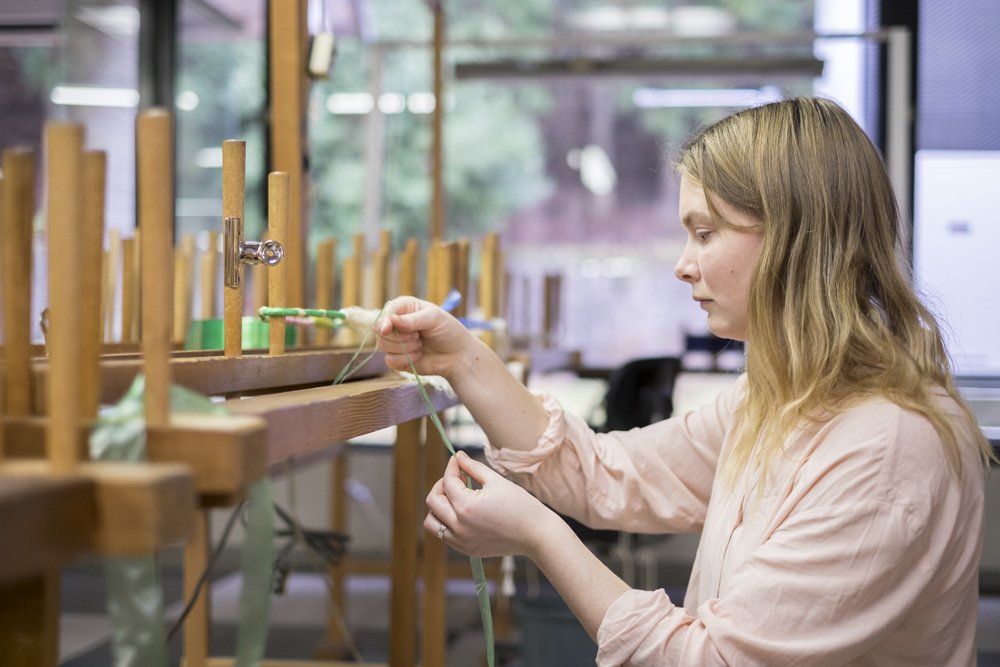The Internationality segment of a series introducing Kawashima Textile School (KTS). We are bringing you interviews with graduates from all over the world who have various relationships with weaving. In this 7th part of the series, we asked Patricia how she came to study at the school from our partner school in Sweden, her impressions of the school, and as a bistro owner, how weaving exists in her everyday life, and what her job at the bistro has in common with weaving from a perspective of making things by hand.
Patricia Schoeneck (Swedish)
Owner of a bistro
Currently living in Sweden
Courses: Foundation Kasuri, Applied Kasuri I (May to June 2012), Applied Kasuri II, III* (October to November 2013) as a foreign exchange student from Handarbetets Vänner Skola
*now part of Applied Kasuri II
-Could you tell us why you chose to study at KTS?
The school HV (Handarbetets Vänner Skola) where I did my weaving studies is a partner school with Kawashima and that was my first way in to discover Kawashima. As I read about the school I felt that it was a wonderful place to study and explore traditional but also modern handcraft in the field of weaving and dyeing techniques.
The atmosphere at Kawashima both impressed and inspired me. The atmosphere of taking creation, craft, and textile extremely seriously. It made no sound, it needed not, it was just there led by teachers and accompanied by the students.
-You first studied at KTS in 2012 and came back to continue studying kasuri after 1.5 years. You wove a large work by yourself at home by combining the techniques you learned at KTS. Did you find any new points of views? You might have found something that you want to learn more clearly, by leaving once in terms of place and time. Perhaps, such a sense of distance may lead to your current lifestyle between working at a bistro and weaving.
Both at Kawashima and in Sweden I had so many ideas and visions about things I wanted to create. Since both dyeing and weaving are pretty time consuming it is not possible to realize every big idea that was growing in my head. I think, when looking back, I had to complete a big work first in order to start making smaller works, samples. And working like that enabled me to create and realize more of my visions. Now in my current lifestyle I might be leaning towards both ways of practicing weaving and creating in general. Since running a bistro takes almost all my time I need to have small/short textile work that is realistic for me to complete but I also need a big over-years-lasting work that I can return to whenever I have some time left.
-How has your experience at KTS influenced you?
It gave me patience and confidence in my ability to succeed towards my visions within weaving, dyeing and overall projects in life.
-How do you use the skills learnt at KTS in your career, life, etc?
I try not to rush, I source to take away unnecessary work or objects that risk to stand in conflict with my final goals or visions.
 |
| Elfviks Gård Bistro |
-Could you tell us the background of renting an atelier, starting to work at a bistro, and then becoming the owner? Perhaps this lifestyle works well for you, as a mother of a small child?
Both the atelier and the bistro are situated in the countryside at a sheep farm. I love nature and old buildings so when I one summer day found that place I knew I wanted to work there. As weaving is hard to make money off of, I had to find other ways to be able to earn my living, especially because my partner and I wanted to become parents soon. So when the former owner of the bistro wanted to leave, I said I could take over. Soon after that our son was born. It is a lovely way to live, although it is very hard and means a lot of work, but I wouldn’t want it any other way.
-From the view of creating things by hand, your bistro job and weaving seems to be related somehow. Do you feel that way?
My bistro job and weaving are related in several ways I think. They are both hard works, takes a lot of time, a lot of unreflected time when you just do what you have to do to accomplish what you started, but they also consist of and start with an idea, a thought, or just a feeling. I bake a lot of buns, cakes, and cookies, and I feel, just as repeatedly that it is, still, satisfaction. Because every once in a while or very often I get the same feeling that weaving gives me. For example, running the bistro is like working with my hands, having something in front of me, a lot of routine, making the same things over and over again, but also here and then, as twinkling stars, the feelings of creation appear and kicks in right to my heart, just like weaving.
-What does weaving mean to you?
At this moment weaving has a small part in my physical day to day life. I run my bistro everyday, with all the work that comes along. But my weaving studio is situated just above the bistro, and every once in a week I go up to the attic and enter the studio and breathe, deep breaths. I know that in a short future of time I will be working there again. Until then I inhale the wonderful scent of fibers and loom and dream about my next textile project.
 |
Visit the Elfviks Gård website or follow Patricia on instagram at @patriciaschoeneck and @elfviksgardsbistro.
Patricia's "Student Voice" article from 2013, with photos of her work in the KTS Graduate Exhibition.

































